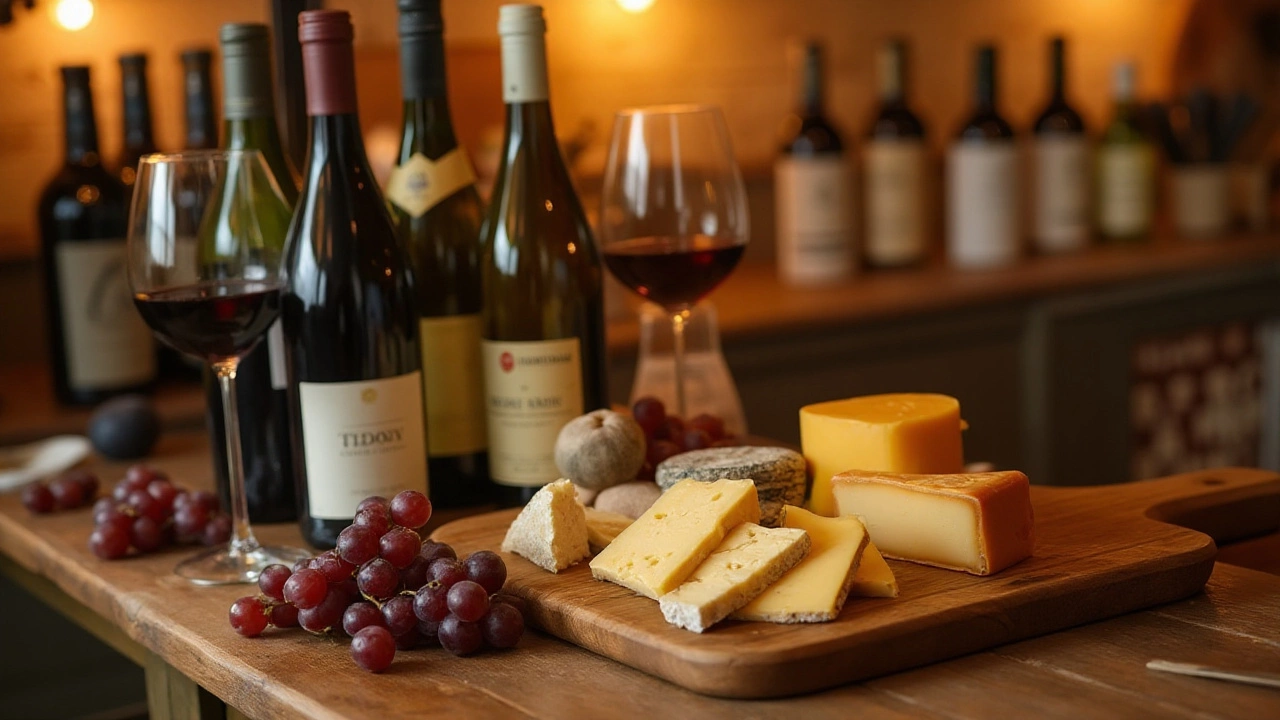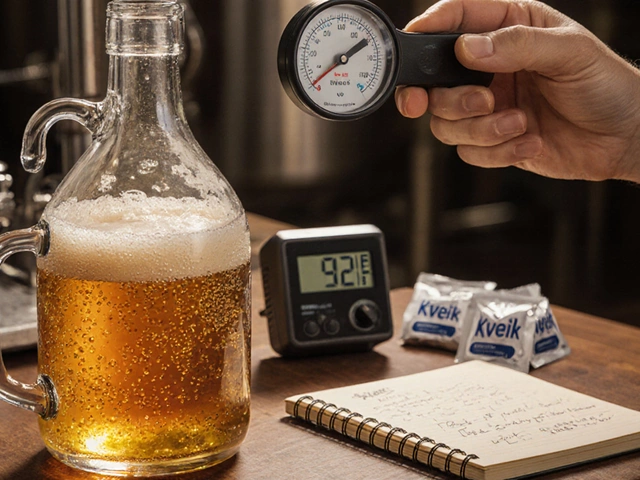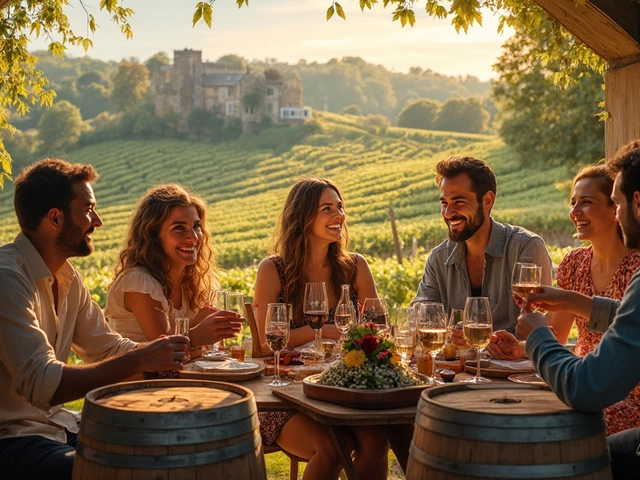Wine and cheese, when paired thoughtfully, can transform an ordinary gathering into a sophisticated affair. It’s not just about choosing any cheese and any wine, but understanding the harmony of flavors that can create an unforgettable experience.
The beauty of this art lies in the symphony of tastes and textures, where the right match can balance, enhance, and bring out hidden flavors in both the wine and the cheese. While there are classic combinations that stand the test of time, there are also exciting new pairings waiting to be discovered by the adventurous culinary explorer.
Join us on a journey through the world of wine and cheese pairing as we delve into the principles and practices that can help you craft the perfect platter. Whether you are a seasoned gourmand or a curious newcomer, there’s always more to learn and enjoy in this delicious realm.
- The Magic of Pairing Wine and Cheese
- Understanding Flavor Profiles
- Classic Pairings That Never Fail
- Adventurous Combinations to Try
- Tips for Creating the Perfect Platter
- Final Thoughts and Inspiration
The Magic of Pairing Wine and Cheese
Imagine the moment when a sip of fine wine hits your palate and mingles with a carefully chosen cheese—the experience can be nothing short of transformative. The key to this magic lies in the nuanced balance of flavors, textures, and aromas that each brings to the table. Wine and cheese have been celebrated companions for centuries, renowned in various cultures for their ability to complement each other. Each type of **wine**, with its own unique balance of acidity, sweetness, and tannins, can bring out new dimensions in a cheese’s flavor profile. Conversely, the fatty, creamy, or crumbly textures of cheese can soften or enhance the characteristics of a wine. This symbiotic relationship doesn't happen by chance but is an art cultivated by enthusiasts and experts alike.
At the heart of successful pairing is the understanding of flavor profiles. Wines can range from sweet to dry, bold to delicate, while cheeses can be sharp, mild, or pungent. The classic pairing concept is to match the intensity of the **wine** with that of the **cheese platter**—a robust red wine might overpower a mild cheese, while a zesty white could be dwarfed by a pungent blue cheese. These fundamental contrasts and harmonies must be understood to fully appreciate the journey that begins with each bite. The science behind this magic involves not just taste but chemistry—acids and fats interact in interesting ways, enhancing mouthfeel and flavor.
Moreover, the textures of cheese, from the creamy softness of a brie to the crumbly sharpness of a mature cheddar, require thoughtful consideration. A cheese's texture can alter the perception of a **wine's** tannins or acidity. For instance, the fat in cheese can coat the palate, toning down the harsh tannins in a red wine, thereby creating a smoother taste. It's much about experimenting within this framework that enthusiasts find their personal favorites. The world's most iconic wine and cheese regions, like France and Italy, have their own traditional pairings, yet even these continue to evolve, inviting modern interpretations.
"Wine and cheese are ageless companions, like aspirin and aches, or June and moon, or good people and noble ventures." — M.F.K. Fisher
For some, the magic of pairing lies in breaking the rules and discovering personal preferences. While many loyal to tradition might vouch for classic pairings like cabernet sauvignon with cheddar or chardonnay with camembert, today’s adventurous palate is not afraid to explore. Unexpected and delightful combinations, such as a sparkling wine with a salty gouda or a rosé with a grassy goat cheese, are gaining popularity. The thrill is often in the discovery—finding that unlikely match that surprises and excites, showing there are as many pairings as there are people willing to try them.
Creating memorable wine and cheese experiences involves a willingness to explore, test, and maybe even make a few missteps. No culinary endeavor is without its experiments, and the world of **wine** and **cheese platter** pairing is no exception. This is why tastings and wine and cheese parties have become beloved social gatherings, offering a chance for both sharing and discovery. It’s about engaging with the senses, understanding and appreciating the subtle art and joy of creating harmony on the palate. Whether you're a novice or a seasoned aficionado, the magic lies not only in the tastes but in the stories, emotions, and moments shared around the platter.
Understanding Flavor Profiles
When it comes to pairing wine with a cheese platter, understanding the intricate tapestry of flavor profiles is key. Each cheese and wine has a distinctive character that can either complement or clash when brought together. For the uninitiated, it might seem a daunting task, but unraveling the world of flavors can be a rewarding experience. The magic often begins with considering the texture, taste, and aroma of both your selected cheeses and wines. Cheeses can range from fresh and light to aged and robust, each style bringing its own flavor chorus. Wines, on the other hand, offer a broad spectrum from dry to sweet, subtle to bold. Recognizing these nuances will allow you to achieve that perfect balance on the palate. This is why many suggest starting with identifying core elements, like acidity, sweetness, bitterness, saltiness, and umami, which can synthesize into the pleasure of dining.
An exciting starting point involves balancing strength with strength. A robust aged cheddar, for instance, might find its perfect partner in a full-bodied Cabernet Sauvignon, where the wine’s tannins can cut through the rich creaminess of the cheese. Conversely, a delicate, creamy Brie might harmonize beautifully with a light-bodied Chardonnay, where oak-aged notes enhance the buttery flavors of the cheese. Cheese’s saltiness often brings out the fruitiness of wine, just as sweet wines can tame the pungency of blue cheeses beautifully.
Steven Jenkins, in his comprehensive treatise 'Cheese Primer', insightfully notes:
"Cheese–that living, emotional, safe, and savory food–is magical. And wine is its natural companion, a wonderfully simple and sheerly unforgettable experience."His eloquent expression underscores that the relationship between wine and cheese is not merely incidental but essential for those who desire to unlock each offering's full spectrum.
To guide this journey of discovery, consider charting flavor notes by developing a reference map. While exploring, you might note that certain wines bring out characteristics in cheese that you hadn’t noticed before and vice versa. Here’s where experimentation thrives - trying different combinations can lead to delightful surprises. Keep an eye on regional pairings as well; often cheeses and wines from the same region have evolved together, making them inherently compatible. For instance, a French Chèvre paired with a crisp Loire Valley Sauvignon Blanc highlights this harmonious evolution.
Finally, a deeper dive into the ingredients and production processes of these delights can reveal unexpected connections and enhance the pairing experience. For those with a detailed fascination, there is always merit in understanding how the particular type of grapes and their fermentation processes influence flavor just as the diet of the animal providing milk influences the cheese profile. Now armed with this arsenal of knowledge, you stand ready to go forth and create a culinary triumph, thinking as much about flavor profiles as varietal and regional considerations in your pursuit of the perfect pairing experience.
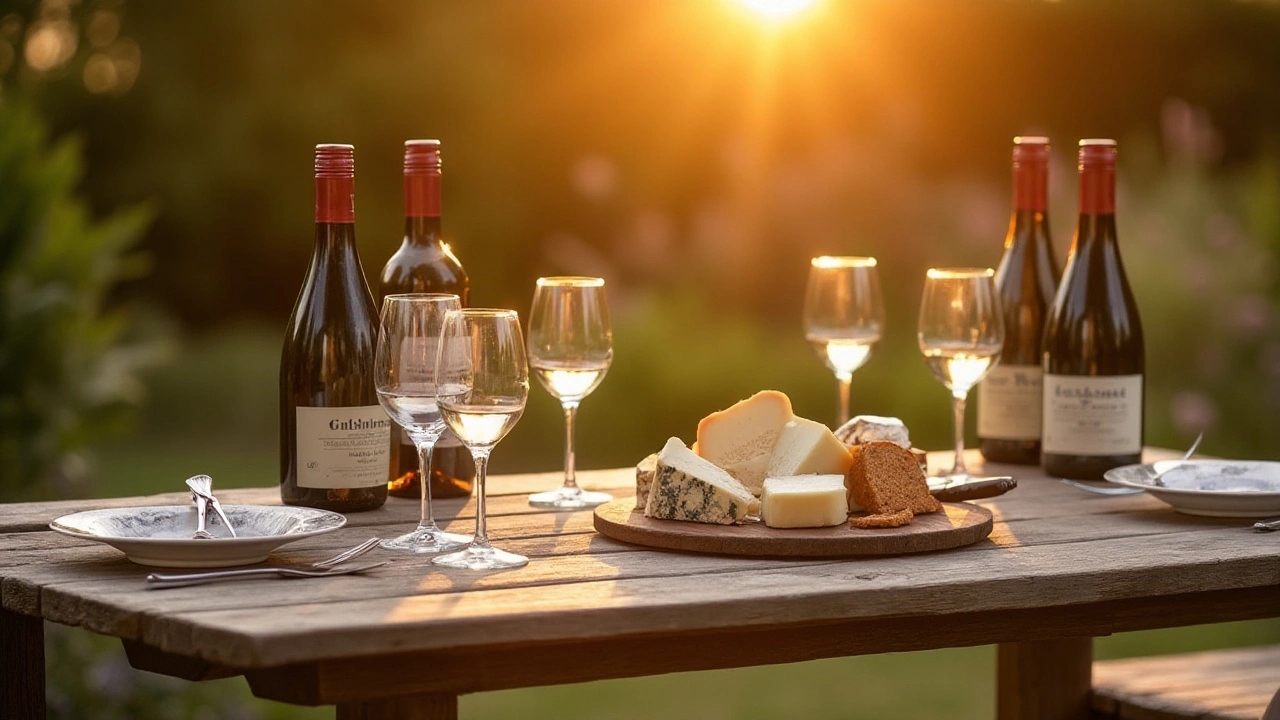
Classic Pairings That Never Fail
Pairing wine with a cheese platter is both an art and a science. There's a sense of magic when a robust red wine meets the sharpness of an aged cheddar, creating a harmonious dance on the palate. This classic pairing works because the bold tannins in the wine cut through the rich, nutty flavors of the cheese, creating a balanced taste experience. On the sweeter side, pairing a fresh goat cheese with a crisp, acidic Sauvignon Blanc is a classic duo — its acidity perfectly complements the delicacy of the cheese, enhancing its creamy texture.
Each wine and cheese brings its own unique personality to the table, making classic pairings a delightful puzzle to solve. A tried-and-true combination is Brie with Chardonnay. The creamy, buttery notes of Brie are a natural match for the rich and flavorful characteristics of a well-oaked Chardonnay. If you prefer something bubbly, Champagne and Camembert offer a sparkling alternative. The effervescence provides a light counterpoint to the cheese’s rich, earthy flavor, resulting in a euphoric sensory experience.
Another beloved pairing is Roquefort with Sauternes. Here, the intense saltiness of the blue cheese finds an exquisite partner in the sweet, honeyed notes of the dessert wine. This mingling brings forward new complex dimensions to both components. Mozzarella with Chianti is another Italian excellence — the cheese's mild flavor aligns with the wine's fruity notes, offering a taste of sunny Tuscan afternoons. Wines with high acidity and faint sweetness, like Rieslings, always couple beautifully with buttery cheeses like Gouda, offering a quite satisfying contrast.
"Much like a great novel, a well-composed wine and cheese pairing is all about balance and structure. When done right, it can be a masterpiece.” – Wine Spectator
Beyond following established matches, consider the color rules: the guideline where white wines typically match better with milder cheeses, and red wines hold their ground with stronger flavors. This isn’t a hard-and-fast rule, but it’s surprisingly effective as a starting point. Sometimes breaking the rules and going beyond expectations gives birth to new classics. Balance in contrast and complement is the maxim. Creamy blue cheeses find friends in bold red wines, while alpine cheeses, aged and full of flavor, rejoice with dry white wines. Whether you're organizing a cozy dinner or a chic party, there’s wisdom in these classic matches to ensure a successful event.
Let’s not overlook one of the all-time greats: Parmesan with a robust Italian red like Barolo or Chianti. The savory intensity of Parmesan finds an engaging sparring partner in the rich tannins and fruit-forward notes of these wines. The combination is both bold and nuanced, offering a sensory trip to the vineyards of Italy.
Adventurous Combinations to Try
In the intriguing world of wine and cheese pairing, venturing beyond the traditional norms can lead to a delightful explosion of flavors. While classics like Brie with Champagne have their revered spot at the table, there’s a thrill in creating combinations that surprise and enchant your taste buds. Imagine the creamy tang of goat cheese paired with a crisp Sauvignon Blanc. These two might not seem instantly aligned at first glance, but the acidity of the wine cuts through the richness of the cheese, creating a refreshing contrast. Such unexpected duets bring excitement and a new appreciation for the subtle harmony that wine and cheese can deliver when joined thoughtfully.
One particularly bold pairing explores the union of blue cheese with a sweet Moscato d'Asti. The pungent and intense nature of blue cheese often begs for a partner that can stand up to its robust character. The effervescent sweetness of Moscato not only complements the blue cheese’s saltiness but also mellows its intensity. The resulting combination illustrates how the right wine can transform the daring character of a strong cheese into a sensational taste experience that wakes up all the senses.
The New York Times describes such pairings as rare instances where "the synergy of two contrasting components results in a taste greater than the sum of its parts."
Another adventurous attempt can involve combining the nutty depth of Gruyère with a slightly fruity Pinot Noir. The red fruit flavors in the Pinot Noir intermingle with the creamy, earthy notes in Gruyère, each unfolds layers of flavors as you savor them. Such combinations are a reminder that wine and cheese pairing often benefits from embracing the unexpected, leaving room for personal experimentation and discovery.
Consider a zesty Zinfandel alongside aged Gouda for a different kind of culinary conversation. Aged Gouda has caramel and butterscotch notes that are enlivened by the bold, spicy profile of Zinfandel, resulting in a vivid flavor profile that captivates the palate. The creativity in choosing such matches allows us to step out of the ordinary and experience the culinary arts at their most exciting.
For those feeling particularly adventurous, a mix of an earthy cheese like Taleggio with a versatile Gewürztraminer can be a stimulating exploration. This pairing gestures to a world of lush, aromatic sensations where the spiced tones of the wine accentuate the cheesy funkiness of Taleggio, creating a depth of flavor that seems to transport you beyond the moment. It's these wonderful, whimsical matches that push the boundaries and challenge the traditions of what wine and cheese can be when they come together.
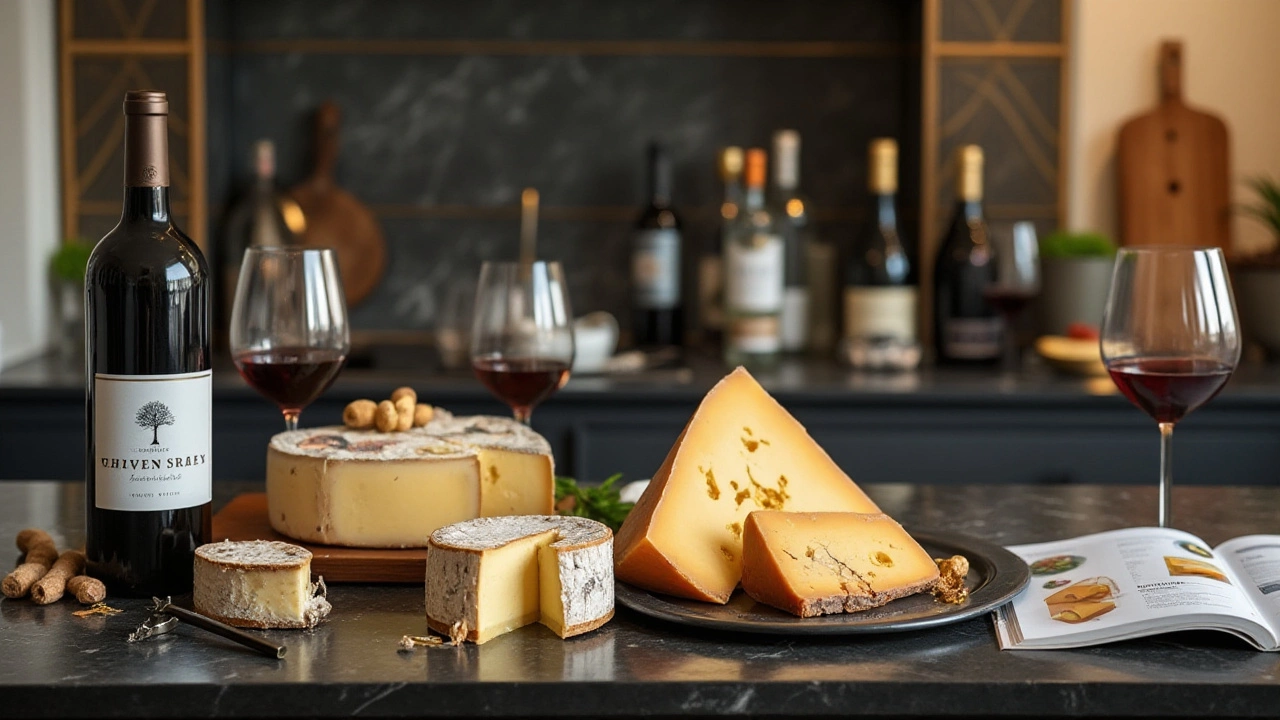
Tips for Creating the Perfect Platter
Crafting the ideal cheese platter to pair with your chosen wine can seem like an art, but it's one that you can master with a few simple guidelines. The key is to balance flavors and textures in a way that will thrill both you and your guests. When assembling a cheese platter, start with a diverse selection of cheeses that vary in taste, texture, and intensity. Include a mix of hard, soft, blue, and aged cheese varieties, providing a delightful spectrum of tastes for everyone to enjoy. Cheese options like creamy Brie, bold Roquefort, nutty Gruyère, and sharp aged Cheddar can be excellent choices. As famed chef and author Julia Child once said, "People who love to eat are always the best people." And indeed, those who appreciate culinary diversity in their wine and cheese selections are best equipped to create an unforgettable experience.
The accompaniments to your cheese choices should complement and elevate the flavors on your platter. Fresh fruits like grapes, apple slices, or berries can add a touch of sweetness, while dried fruits like apricots or figs offer a chewy texture that pairs beautifully with more assertive cheeses. Nuts such as almonds or walnuts bring a satisfying crunch, while cured meats like prosciutto or salami add a savory note that pairs well with many wines. Don't forget to include a selection of crackers or bread, providing a neutral base to cleanse the palate between different pairings.
Presentation matters, and the visual appeal of your platter can enhance the tasting experience. Arrange the cheese and accompaniments on a wooden board or a slate, using small decorative bowls for nuts or olives to keep things tidy. Cutting cheese into different shapes, such as cubes, wedges, or slices, adds visual interest and makes serving easier. Remember, a well-curated platter is a work of art that engages all the senses, not just taste.
Consider including a small tasting guide for each wine and cheese combination on the platter. It not only educates those less familiar with pairing principles but also adds an element of discovery to the tasting process. You can describe the flavor profile of each cheese, the wine it pairs with, and any specific notes or aromas to look for during tasting. This interactive element enhances the experience and leaves a lasting impression on your guests. Hosting a successful wine and cheese gathering can be unexpectedly rewarding, revealing new favorites and refining your own palate preferences along the way.
Lastly, remember that the best wine and cheese platter is the one that brings joy to those who partake in it. Tastes are subjective, and preferences vary widely from person to person. It's essential to enjoy the process of exploring new pairings, seeking out flavors that resonate with you, and sharing those discoveries with others. As the legendary wine critic Robert Parker once remarked, "Wine is not for snobs; it’s a pleasure." Embrace the journey of wine and cheese pairing with an open mind and the willingness to experiment, and you’ll find that the perfect platter is just a few tasting sessions away.
Final Thoughts and Inspiration
Delving into the art of wine and cheese pairing is like embarking on a voyage of sensory discovery. It's an invitation to explore, experiment, and above all, enjoy the myriad possibilities that arise when flavors dance harmoniously together. The allure of a well-composed cheese platter lies not only in its visual appeal but in the complex yet rewarding tapestry of taste it presents. Finding the perfect wine that complements the array of cheeses can elevate your culinary experience, transforming it into a memorable occasion. One can't overstate the importance of taking the time to understand the personalities that each type of cheese and wine brings to the table, and how they interact with one another.
One of the most delightful aspects of creating your wine and cheese pairings is the freedom it gives you to express your personal taste. While there are timeless pairings, like a mature cheddar with a full-bodied Cabernet Sauvignon, which are universally loved, there's always room for experimentation. Try pairing a creamy Brie with a crisp, chilled Chardonnay or introducing a pungent blue cheese to a sweet, sophisticated Port. These unexpected combinations often lead to delightful surprises that challenge preconceived notions of taste. Remember that tasting is subjective; what sings on one palate might whisper on another. Don't hesitate to trust your instincts and explore the endless combinations.
Crafting the perfect platter doesn't just involve selecting the right cheese and wine, but also things like presentation and creating an atmosphere. Use boards made from natural materials like marble or wood, and incorporate fresh fruits, nuts, and artisanal bread as accompaniments. Pay attention to the seasons; in summer, light sparkling wines and fresh goat cheese are a treat, while in winter, stronger, heavier flavors often dominate. Your environment and mood can greatly influence the taste experience, turning a good pairing into a truly exceptional one.
As Alan Richman, an acclaimed food and wine writer, once captured brilliantly, "There is no more greater simplicity, and no greater reward, than sharing great cheese and wine with loved ones."
“Wine makes every meal an occasion, every table more elegant, every day more civilized.” – Andre Simon, Wine and Food ExpertThis sentiment has never been more relevant than today, when sharing an experience is more valued than ever. Whether for a celebration, a quiet evening at home, or any moment in between, remember that the perfect pairing begins with an open mind and a desire to explore. May your journey through the world of wine and cheese be filled with delight, discovery, and delicious finds.
We hope these insights inspire you to delve deeper into the world of wine and cheese pairing. Let yourself be guided by curiosity and passion, and you'll surely create not only wonderful flavors but beautiful memories with every expertly crafted platter. Here's to the magic that happens when cheese meets wine!
